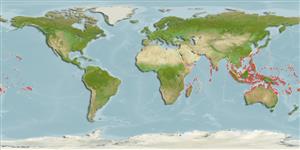Classification / Names
Common names from other countries
Main reference
Size / Weight / Age
Max length : 63.0 cm TL male/unsexed; (Ref. 9710); common length : 35.0 cm TL male/unsexed; (Ref. 9812)
Environment
Marine; freshwater; brackish; reef-associated; catadromous (Ref. 46888); depth range 0 - 5 m (Ref. 89972)
Climate / Range
Tropical, preferred ?; 32°N - 24°S, 30°E - 141°W
Distribution
Indo-Pacific: Red Sea and East Africa to the Tuamoto Islands, north to southern Japan, south to southern Great Barrier Reef and New Caledonia (Ref. 9812).
Countries | FAO areas | Ecosystems | Occurrences | Introductions
Short description
Dorsal
spines
(total): 4 - 5;
Dorsal
soft rays
(total): 8-9;
Anal
spines: 3;
Anal
soft rays: 7 - 9. Olive-brown dorsally, flanks silvery, abdomen white or suffused pale yellow (Ref. 9812). About 6 longitudinal stripes on flanks formed by longitudinal marks on scales; scales also with darkened margins giving slight chequered appearance to flanks (Ref. 9812). Iris with yellow patches (Ref. 9812). Margins of fins dusky, otherwise yellowish white (Ref. 9812). Caudal fin distinctly yellow (Ref. 9812). Pectoral fin completely black in small fish; lower section yellowish in adults (Ref. 9812). No axillary scale visible in the pectoral fins (Ref. 1602).
IUCN Red List Status (Ref. 115185)
Threat to humans
Harmless
Human uses
Fisheries: commercial; aquaculture: commercial; aquarium: commercial; bait: occasionally
More information
ReferencesAquacultureAquaculture profileStrainsGeneticsAllele frequenciesHeritabilityDiseasesProcessingMass conversion
Tools
Special reports
Download XML
Internet sources
Estimates of some properties based on models
Phylogenetic diversity index
PD50 = 1.0000 many relatives (e.g. carps) 0.5 - 2.0 few relatives (e.g. lungfishes)
Trophic Level
2.2 ±0.1 se; Based on diet studies.
Resilience
Low, minimum population doubling time 4.5 - 14 years (Preliminary K or Fecundity.)
Vulnerability
Moderate to high vulnerability (54 of 100)
Price category
